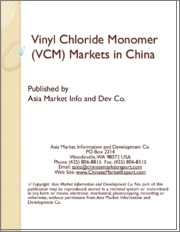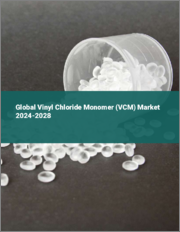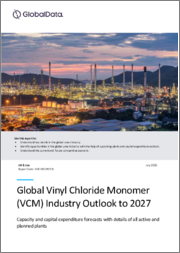
|
시장보고서
상품코드
1535762
염화 비닐 모노머 시장 : 용도별, 최종 용도별, 세계 예측(-2032년)Vinyl Chloride Monomer Market - By Application (PVC, Copolymer Resins, Chlorinated Solvents) By End-Use (Building & Construction, Healthcare, Agriculture, Electrical & Electronics, Automotive) & Global Forecast to 2032 |
||||||
염화 비닐 모노머 시장 규모는 폴리염화비닐(PVC) 수요 증가에 힘입어 2024년부터 2032년까지 연평균 7.7% 이상 성장할 것으로 추정됩니다.
최근 몇 년 동안 폴리염화비닐은 다용도성, 내구성, 비용 효율성으로 인해 건설, 자동차, 포장 등 다양한 산업에서 널리 사용되고 있습니다. 건설 분야에서는 PVC는 파이프, 바닥재, 사이딩 등의 용도로 사용되며, 부식 및 풍화에 대한 내성이 있어 매우 선호되고 있습니다.
보다 효율적이고 환경 친화적인 생산 기술 개발 등 염화비닐모노머(VCM) 생산의 기술 혁신은 전반적인 효율성을 높이고 생산 관련 비용을 절감하고 있습니다. 또한 엄격한 환경 규제로 인해 생산이 환경에 미치는 영향을 줄이기 위해 더 깨끗한 기술과 지속가능한 관행의 채택을 장려하여 시장 성장을 촉진하고 있습니다. 예를 들어, 2023년 1월 Vinyl Institute는 소비자 사용 후 PVC 재활용을 촉진하기 위해 Viability를 시작했습니다.
산업은 용도, 최종 용도 및 지역으로 분류됩니다.
용도별로는 공중합체 수지 부문의 염화 비닐 모노머 시장이 2024년부터 2032년까지 견조한 CAGR을 기록할 것으로 예상됩니다. 이는 향상된 특성과 성능을 필요로 하는 특수 폴리머 응용 분야에 대한 수요가 증가하고 있기 때문입니다.
VCM의 시장 규모는 2024-2032년 헬스케어 최종 용도 부문이 2024-2032년 헬스케어 최종 용도 부문에서 두드러진 수익을 창출할 것으로 예상되며, PVC의 다목적성, 안전성 및 비용 효율성으로 인해 의료용 튜브, 링거백, 일회용 주사기 등 다양한 헬스케어 제품의 소재로 선호되고 있습니다. 소재로 선호되고 있습니다. 멸균이 가능하고 다양한 의료 절차에 적합하다는 점이 이 부문의 성장에 박차를 가하고 있습니다.
아시아태평양의 염화 비닐 모노머 산업은 급속한 산업화와 도시화로 인해 2032년까지 양호한 성장률을 보일 것으로 예상됩니다. 아시아태평양 국가들은 주거, 상업 및 산업 프로젝트를 포함한 대규모 인프라 개발이 진행되고 있으며, 파이프, 바닥재, 전기 케이블 절연재 등 PVC 제품에 대한 수요가 더욱 증가할 것으로 예상됩니다.
목차
제1장 조사 방법과 조사 범위
제2장 주요 요약
제3장 업계 인사이트
- 생태계 분석
- 주요 제조업체
- 유통업체
- 업계 전체의 이익률
- 업계에 대한 영향요인
- 성장 촉진요인
- 건설 및 인프라 개선 프로젝트에 대한 소비지출 증가
- 헬스케어 분야에서의 염화 비닐 모노머 사용 증가
- 자동차 산업의 폴리염화비닐 소비 확대
- 시장 과제
- 염화 비닐 모노머의 건강에 대한 악영향
- 시장 기회
- 새로운 기회
- 성장 가능성 분석
- 성장 촉진요인
- 원료 상황
- 제조 동향
- 기술의 진화
- 지속가능한 제조
- 그린 프랙티스
- 탈탄소화
- 지속가능한 제조
- 원재료의 지속가능성
- 가격 동향(달러/톤)
- 규제와 시장에 대한 영향
- Porters 분석
- PESTEL 분석
제4장 경쟁 상황
- 기업 점유율 분석
- 경쟁 포지셔닝 매트릭스
- 전략 전망 매트릭스
제5장 시장 규모와 예측 : 용도별, 2024-2032년
- 주요 동향
- 염화 비닐 수지
- 코폴리머 수지
- 염소계 용제
제6장 시장 규모와 예측 : 최종사용자별, 2024-2032년
- 주요 동향
- 건축·건설
- 헬스케어
- 농업
- 전기·전자
- 자동차
- 기타
제7장 시장 규모와 예측 : 지역별, 2024-2032년
- 주요 동향
- 북미
- 미국
- 캐나다
- 유럽
- 독일
- 영국
- 프랑스
- 이탈리아
- 스페인
- 기타 유럽
- 아시아태평양
- 중국
- 인도
- 일본
- 한국
- 호주
- 기타 아시아태평양
- 라틴아메리카
- 브라질
- 멕시코
- 아르헨티나
- 기타 라틴아메리카
- 중동 및 아프리카
- 사우디아라비아
- UAE
- 남아프리카공화국
- 기타 중동 및 아프리카
제8장 기업 개요
- Westlake Corporation
- LG Chem(LG Corp)
- Reliance Industries
- Formosa Plastics Group
- Qatar Vinyl Company Petroquimica Innovay
- Nova Chemical
- Jubail Chevron Phillips
- Lyondellbasell Industries
- Occidental Chemical Corporation
- DowDupont
- AGC Chemicals(AGC Inc.)
- Bayer
- Ineos Styrolution(INEOS AG)
- Axiall(Westlake Chemical)
- BASF
Vinyl chloride monomer market size is estimated to witness more than 7.7% CAGR between 2024 and 2032 driven by the increasing demand for polyvinyl chloride (PVC). Of late, PVC is widely used in a variety of industries, including construction, automotive, and packaging, due to its versatility, durability, and cost-effectiveness. In the construction sector, PVC is used in applications, such as pipes, flooring, and siding, where its resistance to corrosion and weathering makes it highly desirable.
Innovations in vinyl chloride monomer (VCM) manufacturing, such as the development of more efficient and Eco- friendly production techniques, are enhancing the overall efficiency and reducing the costs associated with production. Moreover, stricter environmental regulations are encouraging the adoption of cleaner technologies and sustainable practices to help to mitigate the impact of production on the environment, subsequently stimulating the market growth. For instance, in January 2023, the Vinyl Institute initiated Viability for promoting the recycling of post-consumer PVC.
The industry is classified into application, end use, and region.
Based on application, the vinyl chloride monomer market from the co polymer resins segment is poised to witness robust CAGR from 2024 to 2032 due to the increasing demand for specialized polymer applications that require enhanced properties and performance. co polymer resins offer tailored characteristics, such as improved flexibility, impact resistance, and chemical resistance, further adding to their preference.
VCM market size from the healthcare end use segment will generate notable revenue during 2024-2032 attributed to the extensive use in medical applications. The versatility, safety, and cost-effectiveness in PVC makes it a preferred material for a wide range of healthcare products, including medical tubing, IV bags, and disposable syringes. The ability to be sterilized and compatibility with various medical procedures will add to the segment growth.
Asia Pacific vinyl chloride monomer industry is slated to witness decent growth rate through 2032 owing to the rapid industrialization and urbanization. As APAC countries undergo extensive infrastructure development, including residential, commercial, and industrial projects, the need for PVC products, such as pipes, flooring, and electrical cable insulation will further increase.
Table of Contents
Chapter 1 Methodology & Scope
- 1.1 Market scope & definition
- 1.2 Base estimates & calculations
- 1.3 Forecast calculation
- 1.4 Data sources
- 1.4.1 Primary
- 1.4.2 Secondary
- 1.4.2.1 Paid sources
- 1.4.2.2 Public sources
Chapter 2 Executive Summary
- 2.1 Industry 360° synopsis
Chapter 3 Industry Insights
- 3.1 Industry ecosystem analysis
- 3.1.1 Key manufacturers
- 3.1.2 Distributors
- 3.1.3 Profit margins across the industry
- 3.2 Industry impact forces
- 3.2.1 Growth drivers
- 3.2.1.1 Raising Consumer spending on construction and infrastructural renovation projects
- 3.2.1.2 Increasing use of vinyl chloride monomer in healthcare sector
- 3.2.1.3 Growing consumption of polyvinyl chloride in the automobile industry
- 3.2.2 Market challenges
- 3.2.2.1 Negative health impact of vinyl chloride monomer
- 3.2.3 Market opportunity
- 3.2.3.1 New opportunities
- 3.2.3.2 Growth potential analysis
- 3.2.1 Growth drivers
- 3.3 Raw material landscape
- 3.3.1 Manufacturing trends
- 3.3.2 Technology evolution
- 3.3.2.1 Sustainable manufacturing
- 3.3.2.1.1 Green practices
- 3.3.2.1.2 Decarbonization
- 3.3.2.1 Sustainable manufacturing
- 3.3.3 Sustainability in raw materials
- 3.3.4 Pricing trends (USD/Ton)
- 3.3.4.1 North America
- 3.3.4.2 Europe
- 3.3.4.3 Asia Pacific
- 3.3.4.4 Latin America
- 3.3.4.5 Middle East & Africa
- 3.4 Regulations & market impact
- 3.5 Porter's analysis
- 3.6 PESTEL analysis
Chapter 4 Competitive Landscape, 2023
- 4.1 Company market share analysis
- 4.2 Competitive positioning matrix
- 4.3 Strategic outlook matrix
Chapter 5 Market Size and Forecast, By Application, 2024-2032 (USD Million, Kilo Tons)
- 5.1 Key trends
- 5.2 PVC
- 5.3 Copolymer resins
- 5.4 Chlorinated solvents
Chapter 6 Market Size and Forecast, By End User, 2024-2032 (USD Million, Kilo Tons)
- 6.1 Key trends
- 6.2 Building & construction
- 6.3 Healthcare
- 6.4 Agriculture
- 6.5 Electrical & electronics
- 6.6 Automotive
- 6.7 Others
Chapter 7 Market Size and Forecast, By Region, 2024-2032 (USD Million, Kilo Tons)
- 7.1 Key trends
- 7.2 North America
- 7.2.1 U.S.
- 7.2.2 Canada
- 7.3 Europe
- 7.3.1 Germany
- 7.3.2 UK
- 7.3.3 France
- 7.3.4 Italy
- 7.3.5 Spain
- 7.3.6 Rest of Europe
- 7.4 Asia Pacific
- 7.4.1 China
- 7.4.2 India
- 7.4.3 Japan
- 7.4.4 South Korea
- 7.4.5 Australia
- 7.4.6 Rest of Asia Pacific
- 7.5 Latin America
- 7.5.1 Brazil
- 7.5.2 Mexico
- 7.5.3 Argentina
- 7.5.4 Rest of Latin America
- 7.6 MEA
- 7.6.1 Saudi Arabia
- 7.6.2 UAE
- 7.6.3 South Africa
- 7.6.4 Rest of MEA
Chapter 8 Company Profiles
- 8.1 Westlake Corporation
- 8.2 LG Chem (LG Corp)
- 8.3 Reliance Industries
- 8.4 Formosa Plastics Group
- 8.5 Qatar Vinyl Company Petroquimica Innovay
- 8.6 Nova Chemical
- 8.7 Jubail Chevron Phillips
- 8.8 Lyondellbasell Industries
- 8.9 Occidental Chemical Corporation
- 8.10 DowDupont
- 8.11 AGC Chemicals (AGC Inc.)
- 8.12 Bayer
- 8.13 Ineos Styrolution (INEOS AG)
- 8.14 Axiall (Westlake Chemical)
- 8.15 BASF

















